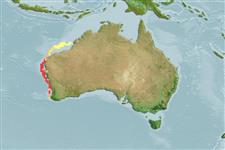Klassifizierung / Names
Namen | Synonyme | Catalog of Fishes(Gattung, Arten) | ITIS | CoL | WoRMS | Cloffa
>
Pleuronectiformes (Flatfishes) >
Bothidae (Lefteye flounders)
Etymology: Psettina: Greek, psetta = grouper (Ref. 45335); senta: From the long-spinned scales on the body..
More on authors: Amaoka & Larson.
Environment: milieu / climate zone / depth range / distribution range
Ökologie
seewasser demersal; tiefenbereich 140 - 333 m (Ref. 33373). Deep-water
Eastern Indian Ocean: Western Australia.
Size / Gewicht / Alter
Maturity: Lm ? range ? - ? cm
Max length : 7.2 cm SL Männchen/unbestimmt; (Ref. 33373); 7.7 cm SL (female)
Kurzbeschreibung
Morphologie | Morphometrie
Body with ctenoid scales, each with a strong and long spinule, except for scales with 2-3 spinules on the lateral line and along the dorsal and ventral margins of the body. Dark rings along the dorsal and ventral margins of the body, not extending onto dorsal and anal fins. All fins pale and without distinct markings (Ref. 33373).
Life cycle and mating behavior
Geschlechtsreife | Fortpflanzung | Ablaichen | Eier | Fecundity | Larven
Amaoka, K. and H.K. Larson, 1999. New species of Psettina (Pleuronectiformes: Bothidae) from off Western Australia, and record of a rare species. Copeia 1999(4):1072-1078. (Ref. 33373)
IUCN Rote Liste Status (Ref. 130435)
Bedrohung für Menschen
Harmless
Nutzung durch Menschen
Mehr Information
NamenSynonymeMetabolismusRäuberÖkotoxikologieFortpflanzungGeschlechtsreifeAblaichenSpawning aggregationFecundityEierEientwicklung
Alter/GrößeWachstumLänge-GewichtLänge-LängeLängenhäufigkeitenMorphometrieMorphologieLarvenLarven Pop.Dyn.RekrutierungDichteBRUVS
ReferenzenAquakulturAquakultur ProfilZuchtlinienGenetikElectrophoresesVererbbarkeitKrankheitenVerarbeitungNutrientsMass conversion
PartnerBilderStamps, Coins Misc.LauteCiguateraGeschwindigkeitSchwimmstilKiemenoberflächeOtolithsGehirngrößeSehfähigkeit
Tools
Zusatzinformationen
Download XML
Internet Quellen
Estimates based on models
Preferred temperature (Ref.
123201): 13.7 - 19.1, mean 15.3 °C (based on 10 cells).
Phylogenetic diversity index (Ref.
82804): PD
50 = 0.5010 [Uniqueness, from 0.5 = low to 2.0 = high].
Bayesian length-weight: a=0.00912 (0.00408 - 0.02036), b=3.05 (2.87 - 3.23), in cm total length, based on LWR estimates for this (Sub)family-body shape (Ref.
93245).
Trophic level (Ref.
69278): 3.5 ±0.4 se; based on size and trophs of closest relatives
Widerstandsfähigkeit (Ref.
120179): hoch, Verdopplung der Population dauert weniger als 15 Monate. (Preliminary K or Fecundity.).
Fishing Vulnerability (Ref.
59153): Low vulnerability (10 of 100).
